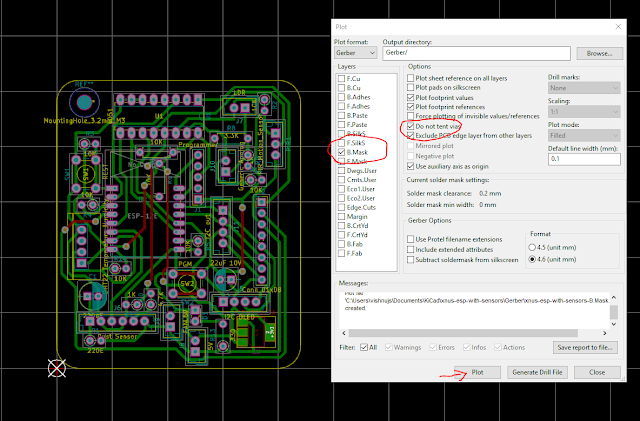Weekend Project: Nerf Dart Counter (Ammo Counter)
Recently I bought a Nerf Retaliator for my son on his birthday. I was scouting thingiverse for some accessories to print like Nerf Sight, then I came across AmmoCounter Mk1 Scope Case by Nathaniel Deal. Ammo counter lets you specify the magazine size and it will count down as you fire each shot. It will let you know how many bullets are left at any point of time. It is particularly useful for rapid fire guns and guns with 12, 18 or higher capacity magazines.
AmmoCounter Mk1 Scope Case has a nice scope face which can accommodate two 7-segment displays, 2 push button switches and an on-off switch. It has a separate compartment for 9V battery, has openings to route the sensor wire and has removable tracks to put it on the tact rail. Over all a very well designed case. I was really impressed with the counter and decided to build one for my son.
Dart Counter mounted on top of the Barrel extension
A small video with Dart counter in action
The case is not perfect for a Retaliator for 2 reasons:
1. The muzzle does not have an option to attach the Barrel Adapter
2. If I attach the case on the priming rail, it interferes with cocking of the gun.
I decided to put the case on top of Barrel extension and to somehow fix a sensor inside the Barrel extension. That way it will be a single unit which can be removed from the gun when necessary.
Read on to find out how I went about doing it.
Micro controller and Electronics:
My initial thought was to hook up an Arduino pro mini (because of the small size) with an I2C OLED display and to attach the IR sensor to the gun. But then I will have to redesign the Scope case to fit an LCD and even otherwise OLED seemed an overkill. I decided to use the case from Nathaniel Deal and build my hardware around it. The requirement was to connect two 7-segment displays 1 on-off switch and 2 momentary push button switch to the scope face. Attach an object sensor of some kind to the Barrel Extension to sense the bullets. Have a micro controller board to control all these.First round, hooked up a 7 segment display to an Arduino Pro Mini board with a 7447 BCD to 7-segment decoder.
Arduino driving a 7-segment display through 7447
Then I realized that the Pro mini has so many GPIOs that I can directly connect two 7-segment displays, 2 switches and a sensor and still be left with a few GPIOs. I had an IR based Obstacle sensor board which I used as the sensor (later this was changed) and the whole setup looked like below, with a whole-lotta wires.
two 7 segment displays, 2 switches and a sensor connected to Arduino
Fritzing sketch to make things clear. I know that it is a bad idea to drive all 14 LEDs with a single resistance, but the general purpose PCB I was using to mount the display did not have enough real estate for individual resistances and I was lazy to make another board.
Fritzing diagram of the setup
Schematic
The obstacle sensor was later replaced with a simple setup as below. Tested the setup and I was getting close to 5V when the IR was directly falling on the sensor and close to 0 when the IR was obstructed. Plenty enough variation for the GPIO to detect it as 1 and 0.
IR LED sensor pair
I used a a general purpose PCB cut to the size of the scope face. Soldered the 7-segment display and the switches onto it. Connected everything to break away headers soldered onto the back of the board and used ribbon cable jumper wires to connect it to Arduino Pro Mini. The ribbon cable is longer than ideal so the case is really crammed. But because of that nothing moves inside the box :-)
Software:
Now for the software part, I wrote a small program in Arduino IDE, the only library it uses is LowPower which makes it easy to put Arduino in power save mode to conserve battery.
At present the code does the following:
- One button cycles through all the predefined magazine sizes, now i have kept 6,10,12 and 18
- Next button resets the counter to now set magazine size.
- Every time a dart goes through the barrel, the count is decremented by 1.
- Once it hits zero and if another shot is fired, it assumes that a new magazine was inserted, and so it goes to set magazine size minus 1.
- It goes to power save mode if the gun is idle for 60 seconds. In power save, the display is turned off and the micro controller goes to deep sleep. Only a button press or another shot can bring it back online.
Code is available at https://github.com/vishnujs-diy/DartCounter
3D Printed parts and assembly
Designed a small sleeve again based on a design I saw from Nathaniel Deal.
I have posted it in thingiverse @ Ammo counter sensor Sleeve for Nerf Retaliator
This sleeve will go inside the Barrel Extension without having to cut or file anything inside the Barrel extension.You will need to drill 2 small holes on the tube inside the barrel to let IR pass through
Dart sensor
Dart sensor once fixed inside the barrel extension
Mounted on the barrel extension
He is happy, I am happy, weekend well spent!











Nice
ReplyDeleteAwesome work!!
ReplyDeleteI am trying this.
BreadBoard.PNG Connect as shown in the picture
But it doesn't work because the compilation is wrong.
What files do you need for the Arduino library?